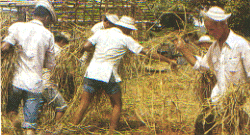Easter is a very special event in Panama. After the
Catholic ceremonies of Thursday, Good Friday, and Saturday
evening, many country side Panamanians celebrate Saturday
night by going to dances. In many cases, Saturday
is a day when families get together and have feasts during
the whole day. It is also common that commercially
organized events such as beach gatherings, bull fights,
cockfights, singing events, and rodeo-like competitions will
take place on Saturday. Easter Sunday includes morning
mass, then a special procession celebrating Christ's
resurrection, and then, in an event that is not part of the
Church's regulated celebrations, people will burn a straw man
that represents Judas. In Guarare, Judas' head is made
of wood and painted. The same head is used year after
year. Most of the time, the straw man is made early
Saturday by a group of townspeople that are early partiers.
These same people often organize a short caravan through town
in order to collect money for fireworks that they stuff into
the straw man and for beverages to keep them going!
Sometime Saturday night, Judas is hung in the middle of the
main plaza, and he will stay there until midday Sunday, when
he is burnt in a comedy-like ceremony. One of Guarare
exports is folklore, and many of the musicians from the most
important country music groups in Panama live in Guarare.
Musicians from other provinces are known to live in Guarare
just because of the festive environment. It is common
that many of these musicians come back from their
performances and stop in Guarare's main plaza to participate
in Judas' wake with other musicians that do not play in
organized groups and with other regular people. Judas'
wake is a continuous party that involves writing Judas'
will and pretending to cry for his death, which usually
involves calling the name of some person in town and having
pretended nervous breakdowns. The burning ceremony
starts, as mentioned before, after the religious ceremonies
of Sunday morning, and includes reading Judas will.
Judas will usually mentions all the scandals of the year, and
brings up many topics that some people in town would rather
forget. There is usually a lot of music and laughter.

